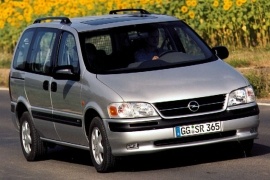OPEL Sintra Models/Series Timeline, Specifications & Photos
First production year: 1997
Engines: Gasoline, Diesel
Body style: Van
General Motors tried to use its experience in minivans and produced a European version for the Chevrolet Venture in its factory from Doraville, Georgia.
While the Chevrolet Venture and the second generation of the Pontiac Trans Sport enjoyed some success on the American market, their European cousin Opel/Vauxhall Sintra had a hard time convincing its customers, and that's why it only lasted for three years on the market. Opel unveiled the MPV in 1996 and completed the engine lineup in the following year. Unfortunately, despite its numerous advantages over its competition, it failed on the market. It was too American for the Europeans' taste.
From the outside, the Sintra featured rear sliding doors, which was unusual for a family vehicle. The car's front fascia featured a pair of tall headlights that resembled those installed on the Opel Omega. A reversed trapezoidal grille with horizontal slats sported the chromed Opel badge in the middle. However, its steep hood and tall greenhouse didn't look as sleek as the carmaker's main competitors, the Volkswagen Sharan and Ford Galaxy.
Inside, a tall and vertical dashboard featured a center stack for the radio and climate-control system. As an option, Opel provided a CD player. The Sintra sported a four-dials design in the instrument cluster, with a wide speedometer in the middle flanked by the tachometer and the fuel and coolant temperature gauges. Its standard seven-seat cabin provided good comfort for the first and second seat rows and limited for the third one. Still, it offered the most expansive interiors in its class.
Under the hood, the Sintra offered a choice of three engines. Unfortunately, the turbo-diesel version was introduced only in late 1997, and that badly hurt the car's sales.
